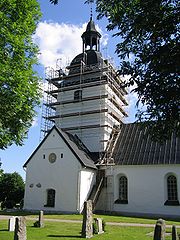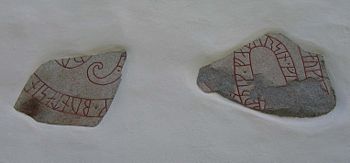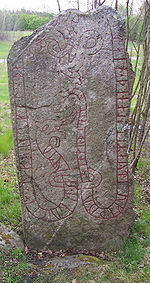
Färentuna Runestones
Encyclopedia

Rundata
The Scandinavian Runic-text Data Base is a project involving the creation and maintenance of a database of runic inscriptions. The project's goal is to comprehensively catalog runestones in a machine-readable way for future research...
catalog that are located in Färentuna, Uppland
Uppland
Uppland is a historical province or landskap on the eastern coast of Sweden, just north of Stockholm, the capital. It borders Södermanland, Västmanland and Gästrikland. It is also bounded by lake Mälaren and the Baltic sea...
, Sweden
Sweden
Sweden , officially the Kingdom of Sweden , is a Nordic country on the Scandinavian Peninsula in Northern Europe. Sweden borders with Norway and Finland and is connected to Denmark by a bridge-tunnel across the Öresund....
. Runestones U 20 and U 21 were registered separately although they come from the same original runestone and consequently are called U 20/21. The runestone U 20/U 21 is probably most interesting as it, together with the Hillersjö stone and the Snottsta and Vreta stones
Snottsta and Vreta stones
The Snottsta and Vreta stones are individual runestones known as U 329, U 330, U 331 and U 332. They are found on the homesteads of Snottsta and Vreta, and they tell in Old Norse with the younger futhark about the family story of Gerlög and Inga in 11th century Uppland, Sweden, together with the...
, tells the story of the family of Gerlög and Inga
Gerlög and Inga
Gerlög or Geirlaug and her daughter Inga were two powerful and rich women in 11th century Uppland, Sweden. Gerlög and Inga had their dramatic and tragic family saga documented for posterity on several runestones...
. All of the Färentuna runestones are inscribed in the younger futhark
Younger Futhark
The Younger Futhark, also called Scandinavian runes, is a runic alphabet, a reduced form of the Elder Futhark, consisting of only 16 characters, in use from ca. 800 CE...
.
U 20/U 21

Snottsta and Vreta stones
The Snottsta and Vreta stones are individual runestones known as U 329, U 330, U 331 and U 332. They are found on the homesteads of Snottsta and Vreta, and they tell in Old Norse with the younger futhark about the family story of Gerlög and Inga in 11th century Uppland, Sweden, together with the...
. This runestone is believed to have been raised by Inga in memory of her husband Eric (Eiríkr) and her father Godric (Guðríkr). The runestone has been attributed to the runemaster
Runemaster
A runemaster or runecarver is a specialist in making runestones.Most early medieval Scandinavians were probably literate in runes, and most people probably carved messages on pieces of bone and wood. However, it was difficult to make runestones, and in order to master it one also needed to be a...
known as Torbjörn or Þorbjôrn Skald, who signed the Hillersjö stone.
Transliteration
- ... ...k * bunta sin ... auk -... ...(u)þrik * faþur sin * gu... ...-b... ...n- *
Transcription
- ... [Æiri]k(?), bonda sinn ... ok ... [G]uðrik, faður sinn. Gu[ð hial]p[i a]n[d].
Translation
- ... Eiríkr(?) his/her husbandman ... and ... Guðríkr, his/her father. May God help (his) spirit.
U 22

Transliteration
- ulfr * uk uikil + uk syrkil * þa... ...- stain * þina i(f)(t)iR ayt--u faþur sin ku*þ (h)ia[lbi] a-t
Transcription
- UlfR ok Vikell ok Syrkell/Sørkell þæ[iR] ... stæin þenna æftiR
, faður sinn. Guð hialpi a[n]d.
Translation
- Ulfr and Vékell and Syrkell/Sørkell, they ... this stone in memory of ... their father. May God help (his) spirit.

